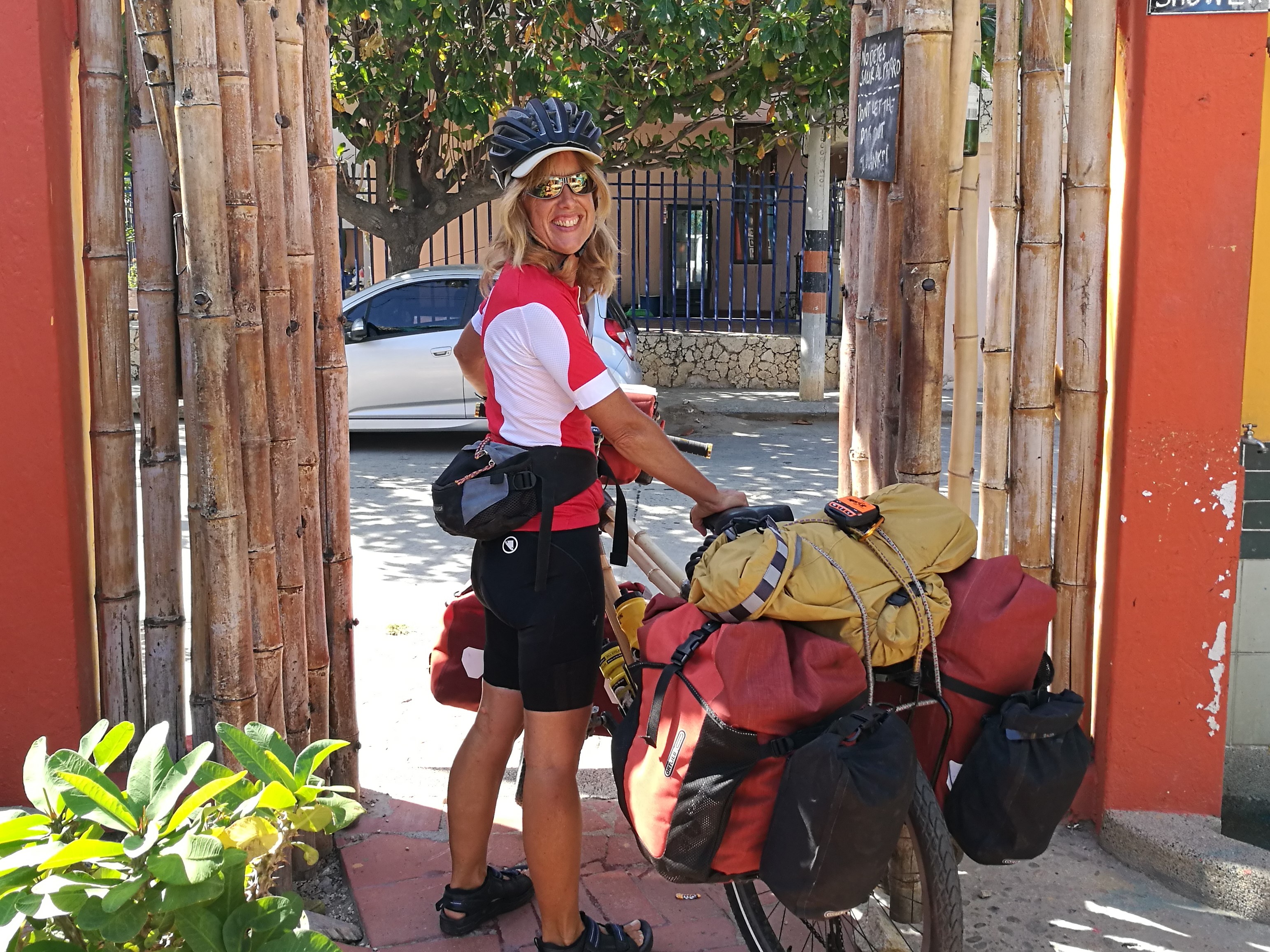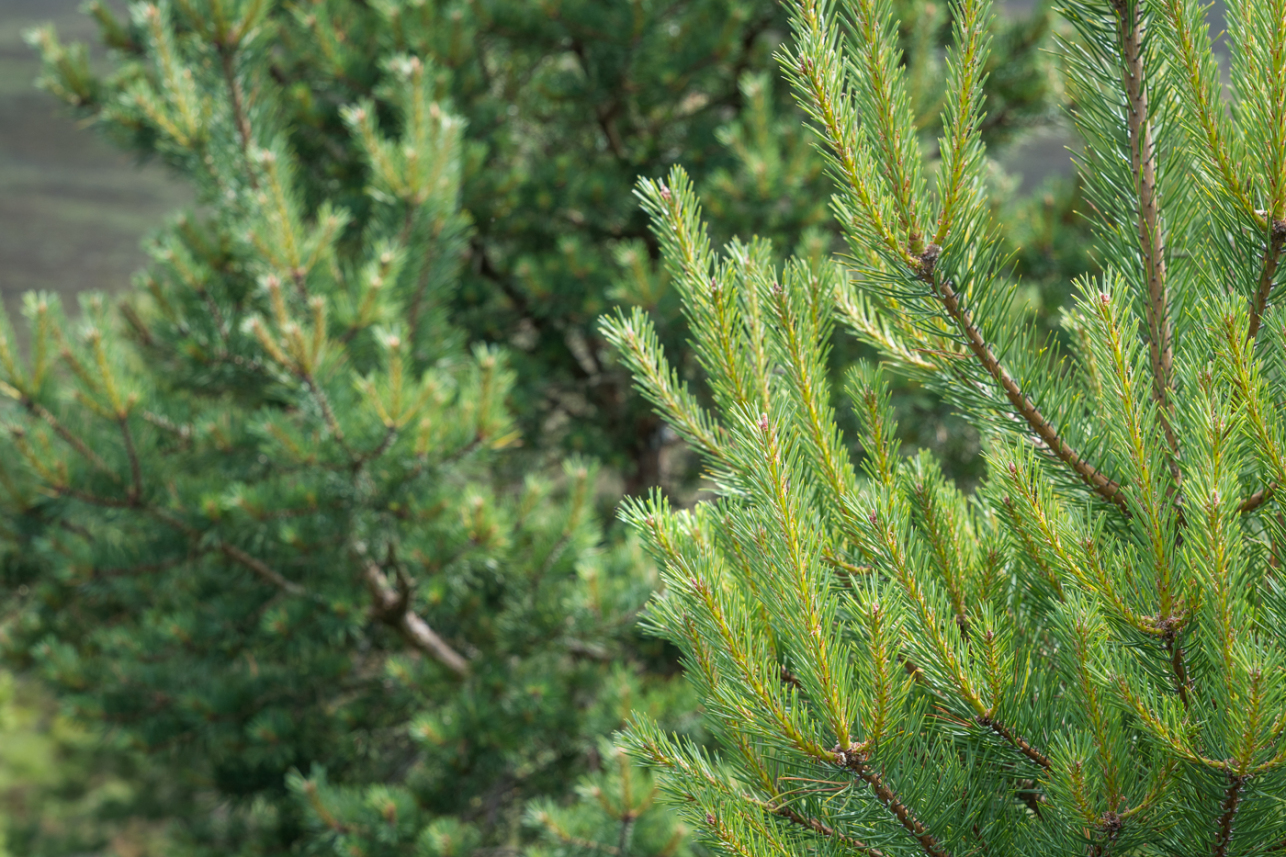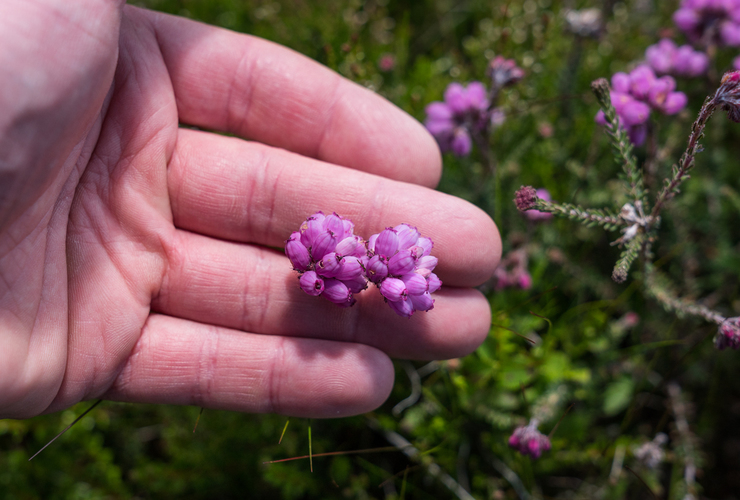Interview: Kate Rawles on The Life Cycle
Having spent a year cycling on a bamboo bike, exploring South America's biodiversity, Kate Rawles has charted her incredible journey in a new book - The Life Cycle. Graham Watson learns more.

Explain how this latest journey actually started many years ago.
My youthful dreams involved a romanticised notion of ‘adventure’; both alluring and, thanks to reading too many books by Wilfred Thesiger, seemingly out of reach for an unathletic, weedy and, oh yes, female, child. It was the bicycle that made adventure possible for me. A bicycle is a magician, transforming journeys that would be mundane in a car or a bus into mini-adventures, and facilitating an open and immersed experience of the people and places you are cycling amongst. Over the years I cycled further and further and, despite an enduring lack of physical prowess, fell in love with cycling in mountains especially.
At the same time, I was finding out about climate change and other major environmental issues. Learning that climate change negatively impacts mountain ecosystems sooner and with more severity than anywhere else nearly broke my heart. I wanted to find a way of riding my bike in wild places that would not just be a wonderful personal adventure, but would also give something back to the places I was adventuring in. This gradually evolved into the idea of ‘adventure plus’ – using adventurous journeys to raise awareness and inspire action on our most urgent environmental challenges.
The first of these was The Carbon Cycle, back in 2006. I cycled from Texas to Alaska following the spine of the Rocky Mountains and exploring climate change in two of the most oil-intensive, oil-dependent countries on earth. Then I came back and used the journey as the basis for climate-communication slide shows and, many years later, a worst-selling book.
My more recent ‘adventure plus’ journey, The Life Cycle, was prompted in part by a growing desire to get back on the road and into the mountains, and in part by a diagram that shocked the sox off me. It summarised research by Johan Rockström and a team of scientists who were essentially arguing that biodiversity loss was even more dangerous than climate change. Could that possibly be true? And, what would that mean for actual animals and plants on the ground? The Life Cycle was an attempt to answer those questions. The journey involved over a year of cycling, mostly solo, the length of South America, following the spine of the Andes – the longest mountain chain in the world – and exploring biodiversity. What is it, what’s happening to it, why does it matter and, above all, what can be done to protect it?
What was important to you about how you undertook this ride? Was it all about the bike?
The bike – Woody – has definitely become a star character in the story. I built Woody myself on a course run by the Bamboo Bicycle Club in London, using bamboo that came from the Eden Project in Cornwall. We think Woody is the UK’s first home grown bicycle…. All bikes are pretty good on the carbon footprint front (though the bike industry and all the consumerism associated with it has a way to go for sure) but a bamboo bike has an even lower footprint. (To be clear, it’s the frame that is bamboo, the rest of the components are standard.) The joints are made of hemp soaked in a vegetable-based epoxy so there’s a small reduction in environmental impact there too. And I loved the idea of doing a biodiversity bike ride on a bike that used to be a plant! More importantly though, the eccentric looking bike that everyone was drawn to was (and is) a symbol of living by your values, and it opened up conversations about all sorts of things, including how to adventure with a lighter footprint. This is a conversation that is underway but that urgently needs to become more widespread – and acted on.
But it’s not all about the bike despite this. In terms of carbon, it was much more significant that I crossed the Atlantic (and came back again) on a cargo ship rather than by plane. This, according to Mike Berners-Lee, reduced my CO2e footprint from about two tonnes to about 50kg. Interestingly, Mike also calculated that I reduced my impact even more by powering my pedalling with a vegetarian rather than a meat-based diet. The meat industry – especially but not only the beef industry – is one of the biggest drivers of biodiversity loss as well as climate change, and it was really important to me to be walking the talk (or pedalling the talk?!) as far as possible in these kinds of ways on this journey.
Another important aspect alongside keeping the negative impacts of my journey as low as I could, was the way I was able to cycle through the topic I was exploring. Biodiversity includes diversity of habitats and ecosystems as well as of species, and my route took me from the Caribbean coastline through hot, lush lowlands into high paramo grassland; from cloud and rainforests, some of the most biodiverse ecosystems on earth, to the Atacama desert and the Bolivian salt flats and the high, classic, spikey white mountains of the Peruvian Andes. What’s happening to biodiversity is catastrophic, yet we still don’t hear as much about it as we do about climate change (important though that is, of course.) On this ride, I realised that the natural world is even more wonderful than I already knew and this witnessing and celebration of biodiversity is key in the resolve to do whatever it takes to protect it. It also made learning about the terrible impact we’re having on it, and witnessing this too, even more impactful, of course.
Along the way, I was meeting with conservationists and environmentalists; visiting projects and people who are working in a wide range of brilliant, often original ways, sometimes at great personal risk, to protect biodiversity, wild places and local communities. These meetings were a hugely important aspect of the journey too.
Did it go to plan or did you find unexpected challenges?
Well, this kind of assumes there was a plan….! But seriously. The ‘plan’ was deliberately light touch. I would cycle north to south, stay in amongst the Andes for most of the route, and meet up with as many activists as possible (understanding the term widely, as anyone working on behalf of biodiversity/nature/the living world). Some of those I made contact with before I left, but most would be set up as I went along. And I would give myself double the time I thought I would need.
The more obvious challenges included still not having enough time to do the journey and meet everyone I could have met – contacts kept leading to other contacts and amazing invitations and opportunities which eventually I had to start saying no to – very frustrating! It seems that if you have a journey with a fixed destination in time and place in combination with an open itinerary, you will generate time pressure for yourself, no matter how much of it you think you have when you set off. In addition, while I absolutely loved almost all of the cycling, some of it was very hard work, obviously, or challenging in other ways. (I’m a rubbish mountain biker having mostly cycled on road my whole life, so the off-road sections were interesting at times!) And I learned that I’m also rubbish at languages – my Spanish, which was poor when I set off despite numerous classes, really didn’t improve all that much and certainly not as much as I’d hoped or anywhere near enough to have complicated conversations about biodiversity conservation!
The biggest challenges were the intellectual and emotional impact of some of the encounters and much of what I discovered. What I thought was a detour to meet some anti-goldmining activists in fact turned out to take me right into the dark and glittering heart of the story. It took me off in a direction I hadn’t expected – encounters with various forms of extractivism. I learned a huge amount about the horrendous impacts of these and other eye-wateringly powerful mega-industries on nature and people, and the bravery of the activists trying to protect their communities, ecological and human, against them. Understanding the links between my consumption as a (relatively!) wealthy westerner and the devastation being wreaked on ecological and human communities in South America and round the world was really tough – but necessary as well as horrifying.
So there are many aspects to this journey. Which are the most important to you, and how do they relate to each other?
The most important has to be the story about biodiversity. We are currently losing species and habitats at such a rate it’s been called the sixth great extinction, caused for the first time in Earth’s history by a single resident species. Us. Or some of us. Biodiversity is not a luxury. It’s vital to all life on earth. In sum, biodiversity gives us ecosystems, and ecosystems give us so-called ‘ecosystem services’. I hate the language because it instrumentalises nature, but the point is that ecosystem services are things like fresh air, clean water, fertile soil, pollination – things we literally can’t live without. And, of course, ‘biodiversity’ and ‘ecosystems’ are communities of living beings, who are every bit as entitled to be here as we are. Trying to raise awareness of all this, and to inspire all of us to take action in whatever way we can, was The Life Cycle’s overall aim. But I strongly believe in doing this in ways that make us feel alive, and in my case the way to do this was via the adventure. So the adventure story is an important aspect too – in its own right as well as an attempt to communicate in what is (hopefully) an engaging and accessible way.
There was a lot going on! The cycling, meeting projects, sharing the story, writing a book, inspiring action. What’s been the biggest challenge and the biggest satisfaction?
The biggest challenge by far has been writing the book. Forget riding the length of the Andes as a not especially athletic person on a heavily overloaded bicycle – writing the book was way, way harder. And it took a lot longer too – the best part of five years as opposed to thirteen months. I’ve had periods of the worst despair over the book, convinced at one point that I’d just spent those five years, which were a gamble in terms of the most effective thing I could do as an activist, writing an overly long pile of tedious dross that no-one would ever read, let alone be inspired to act by. So the biggest satisfaction is when people say the book is actually not that bad. Even better, that it’s helped strengthen their understanding, not just about the vital importance of biodiversity and of taking action, but of the interconnectedness of all our major environmental challenges and the fact that we can’t tweak our way out of them. We need profound changes to our values and worldviews – especially in relation to the other than human world – as well as to our economic and political systems. If the adventure story helps get that across, that’s immensely satisfying. And of course adventure is a powerful metaphor here, as well as a communication medium. The transition we need to make as societies and as individuals, from where we are, to genuinely sustainable ways of living and working, is immense. If we think of that as an adventure rather than a tedious, difficult burden or sacrifice, that helps bring out the best in us, and a ‘yes, we can do this’ up for it sort of attitude.
The ride was obviously a massive challenge, as is the biodiversity crisis. What’s the reaction been like – are people celebrating the ride or are they stepping up their action for nature? How do you feel about that?
The first set of questions after I give a slide show talk are almost always about the ride… But then we usually get into a discussion about what we can do, and that’s when it gets interesting, gratifying and of course, complicated. In a way, it’s much easier to answer the question ‘What can I do to make a difference?’ in relation to climate change than biodiversity loss. I think key is to begin by knowing about what’s happening to biodiversity, what’s driving this, and how urgent resolution now is. Then it’s about identifying your own strengths, weaknesses and sphere of influence. And about asking the question ‘What can I do?’ not only from the perspective of being a consumer – which is how we are often primarily positioned – but also about what we can do as citizens; as catalysts; and as communicators. No doubt there are other categories too… There are things we can do as consumers, of course, from eating less meat, to consuming less and better in general, to flying less, etc. But it’s arguably even more important to ask questions and identify actions in relation to what we can do to support everyone in understanding the urgency of the issues, and to bring about the systemic changes needed to tackle them.
It was great that you used your journey to complete a John Muir Award, which has to be the most ambitious Award to come out of Cumbria. Why did you do that?
I wanted to do everything I could to use the journey to raise awareness of the issues and to inspire action, and so doing it as a John Muir Award was an excellent way to help amplify that. On top of which I happen to be a fan of the work of the John Muir Trust and of the award especially – many of my students were inspired by it when I taught at the University of Cumbria back in the day. It would be wonderful if my journey encouraged others to make their own journeys on behalf of wild places and biodiversity. And of course, they don’t have to involve cycling the length of the Andes or even going all that far from home. Most of my own engagement with nature and other species happens close to home – and that’s by far the most important form of engagement in terms of keeping me motivated and reminding me why I’m doing what I’m doing.
Your book was published on 1 June 2023. Do you have plans for a book tour?
Yes, absolutely! The first part of the tour is already well underway, and has involved a mix of Royal Geographical Society regional talks, book shop events, literature festivals, cycling festivals and so on. A lot of invitations arrive when a book first comes out but after that, I’m hoping to set up the UK Life Cycle, visiting wild places, and places where biodiversity is either celebrated or being threatened (or both). Closing what’s been called the ‘inspiration/action gap’ is a real challenge, and the aim would be to engage very deliberately with the question of what particular audiences can do for biodiversity in their location (as well as inspire, hopefully, not instead of!) I’m looking for partners in this, both in terms of possible venues and locations, and shared values and aims…. Suggestions welcome!
And beyond that, any more adventures?
See above! My plan is to set up the UK Life Cycle so I can cycle from event to event, towing books in a trailer… One thing I’ve already learned is that books are heavy (who knew!) so that will definitely be an interesting challenge and help recover the fitness I lost over all those years of writing about cycling rather than actually cycling. Beyond that, there are some ideas about a Wild Cycle, visiting rewilding and ecological regeneration projects across Europe. And beyond that, I’d like to head off into the hills with my bike with absolutely no agenda whatsoever!
- This is a full version of an interview that ran in the autumn 2023 issue of the John Muir Trust's Members' magazine - the Journal. Find out more about writer and former university lecturer in enviornmental philosophy Kate Rawles and her book The Life Cycle.
- Graham Watson is the Trust's John Muir Award Manager, Cumbria.

Wild Action Fund
Help us connect people with wild places and inspire positive action for nature

